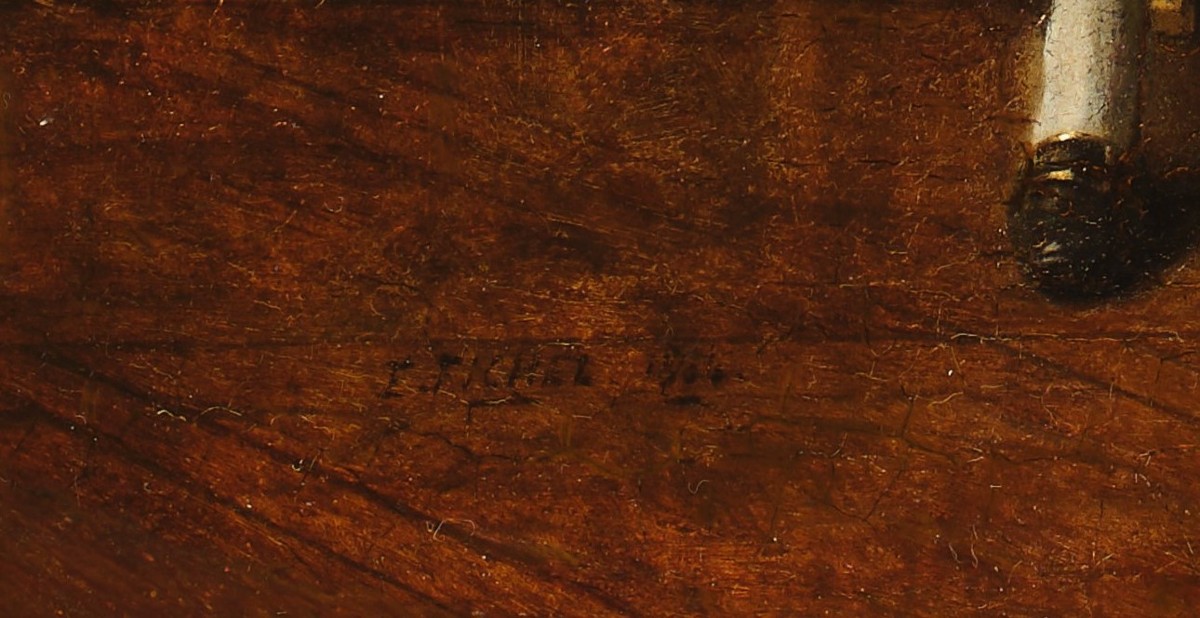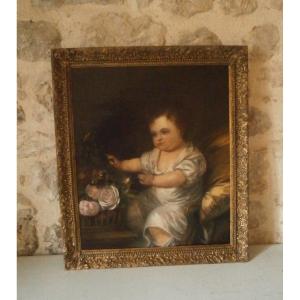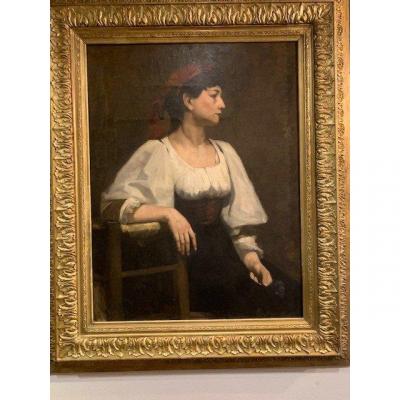Napoleon in his study
1864
Signed and dated “E.Fichel 1864”
Oil on panel
28.5 x 21.3 cm without frame, 50.5 x 45 cm with its original frame
11 ¼ x 8 3/8 in. without frame, 19 7/8 x 17 ¾ with its original frame
Exhibition
Probably presented at the annual exhibition of the Cercle de l’Union Artistique 1865
Provenance
Probably collection of Princess Mathilde Bonaparte
French private collection
Benjamin Eugène Fichel
Benjamin Eugène Fichel was born on August 30, 1826 in Paris. His precocious talent allowed him to enter the École des Beaux-Arts at the age of fifteen, where he ultimately became a student of Martin Drolling and Paul Delaroche. Given his very young age and the rigorous training necessary to be a student at the École des Beaux-Arts, Fichel only exhibited his first painting at the Salon of 1849, where he presented a Holy Family, the Portrait of Hadji- Add-Hamid-Bey, and the Portrait of M.L. Fichel subsequently exhibited regularly and extensively at the Salon, starting with numerous portraits, but later exhibiting mainly genre scenes inspired by the 18th century. He also successfully tried his hand at the great genre: history painting with paintings such as Open in the name of the King at the Salon of 1867. Among his favorite historical themes is the Napoleonic legend. In a style very close to Meissonnier, he painted episodes featuring Napoleon I. Thus in 1865 at the annual exhibition of the Cercle de l’UnionArtistique he presented three Napoleonic paintings, including a Napoleon in his study which is probably our painting. These works were noticed by the press and in particular by the great critic Louis Auvray who wrote on this subject: “Mr. Meissonier's rival, Mr. Fichel, has become a true history painter. His color has less brilliance than that of the leader of the school of microscopic painting, but it is more severe, more solid, qualities which suit these three subjects which he treated with talent: the first visit of Madame de Beauharnais to General Bonaparte; Napoleon dictating orders, and Napoleon in his study. The latter is today in the salons of Her Majesty Princess Mathilde, to whom itbelongs.»[1] During his career at the Salon, Fichel received several awards and continued to exhibit there until his death in 1895. He received a third class medal in 1857 for A Dramatic morning; a mention in 1861 for several works including The First Lesson of Arms, Itinerant Singers, In a Cabaret and Baptism of Miss Clairon; a medal in 1869 for The Night of August 24, 1572, before the Massacres and The Fool Who Sells Wisdom; and a silver medal at the Universal Exhibition of 1889. Fichel obtained one of his highest honors in 1870 when he was named a knight of the Legion of Honor. At the end of his career, he had conquered "an envied place among the genre painters of the French school of the 19th century", he died in 1895 in Paris. Many of these works are today preserved in public collections and in particular at the Orsay Museum, The Chateau de Malmaison, the Magnin Museum, as well as in the Fine Arts museums of the cities of Dijon, Lille, Rennes, Rouen and Bordeaux, but also in foreign institutions such as the Royal Collection or the Amsterdam Museum.
A famous image
Few of the works representing Napoleonic subjects by Fichel have come down to us. However, in 1864, the year our work was completed, he painted two other paintings on the subject of the Empire and which he presented at the Salon of 1865, these were Napoleon returning Eugene's father's sword and Napoleon combining his maneuvers.This production of subjects drawn from the Empire for which he was widely praised by critics remains a priori unknown to this day except for our work.The scene takes up the iconographic tradition of depicting Napoleon in his study.This image immortalized by Jacques-Louis David and other artists such as Jean-Baptiste Isabey places the emphasis on the head of state. He is generally represented surrounded by objects of power such as administrative documents, the Civil Code in David's painting or the map in our work. The painting also highlight Napoleon's hard labor. The monarch was indeed known to sleep very little and spend most of the night in his office. With David it is the burnt-out candle which gives this indication, with Fichel it is the rather dark atmosphere of the painting which reveals Bonaparte's nocturnal work. Our artwork fully corresponds to Fichel's critically acclaimed small-format historical paintings. On an oil on panel allowing a precise and incisive line, the artist paints the portrait of a statesman. Sitting, dressed as a general, he studies a map, seeming to be thinking about his next maneuvers. The painter, in a very intimate format, pays homage to the great strategist that Bonaparte was. In a cozy atmosphere hidden from view, it invites the viewer to share the intimacy of the great man and thus enter a part of History.
[1] Auvray Louis, Revue artistique et littéraire, aux bureaux de laRevue, Paris, 1865, p.100
Literature
- Auvray Louis, Revue artistique et littéraire, aux bureaux de la Revue, Paris, 1865
- Le Pays : journal des volontés de la France, 08-02-1865
- Véron Pierre, Les coulisses de la vie artistique, E. Dentu, Paris, 1876
- Montrosier Eugène, Lesartistes modernes ; contenant quarante biographies, Quatrième partie :Peintres divers, Librairie artistique, Paris, 1884





















 Le Magazine de PROANTIC
Le Magazine de PROANTIC TRÉSORS Magazine
TRÉSORS Magazine Rivista Artiquariato
Rivista Artiquariato